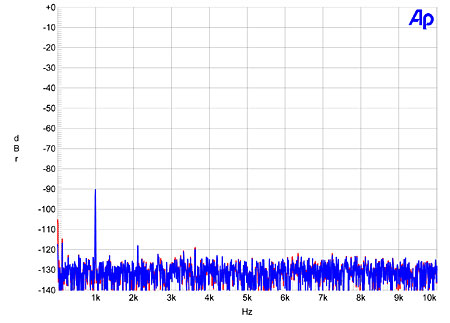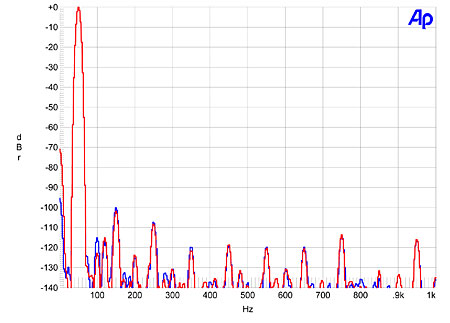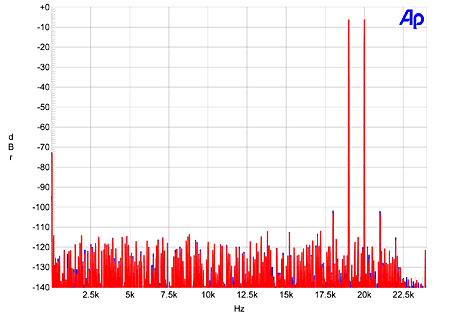| Columns Retired Columns & Blogs |
Bryston BCD-1 CD player Measurements
Sidebar 3: Measurements
I examined the Bryston BCD-1's measured behavior mainly using Audio Precision's top-model SYS2722 system (see www.ap.com and "As We See It" in the January 2008 issue), as well as, for some tests, our Audio Precision System One and the Miller Audio Research Jitter Analyzer. As always, I experimented with the grounding between the player being tested and the test set to give the lowest level of measured hum.
The BCD-1's error correction was excellent; the player suffered no dropouts until the gaps in the data spiral on the Pierre Verany Test CD reached 1.5mm in length. When I test a CD player's error correction, I monitor the data output words using RME's DIGICheck utility program, and thus was able to notice that bit 18 in the BCD-1's digital output was permanently set to "1." I doubt this would have any audible consequences if the BCD-1 were to be used only as a transport, but it is somewhat peculiar behavior.
The Bryston's maximum output level at 1kHz from the unbalanced RCA jacks was 2.38V, or 1.5dB above the CD standard's 2V. The maximum balanced output level from the XLR jacks was exactly twice this value, and both sets of outputs preserved absolute polarity; ie, were non-inverting. (The XLRs are wired with pin 2 hot.) The unbalanced output impedance was low at high and middle frequencies, at 74 ohms, rising to a still low 106.5 ohms at 20Hz. The balanced output impedance was exactly twice these figures, as expected.
The BCD-1's frequency response is shown as the top pair of traces in fig.1: perfectly flat from 10Hz to 10kHz, with a negligible 0.1dB droop at 20kHz. The bottom pair of traces in this graph is the response with preemphasized data. Like players from Simaudio and Naim, the BCD-1 shows a fairly large suckout in the mid-treble, meaning that preemphasized CDs will sound a bit distant and lacking in dynamics. Fortunately, such discs are rare these days, though I believe the BIS catalog was all mastered using preemphasis. Channel separation (not shown) was superb from both sets of outputs, at 130dB in the midrange, and still better than 115dB in the top octave.

Fig.1 Bryston BCD-1, frequency response at –12dBFS into 100k ohms with normal data (top) and preemphasized data (bottom). (Right channel dashed; 0.5dB/vertical div.)
Fig.2 was plotted using a 1/3-octave-wide bandpass filter with a center frequency swept down from 20kHz to 20Hz while the BCD-1 played dithered data representing a 1kHz tone at –90dBFS. The traces peak at exactly –90dBFS, suggesting very low linearity error, and are free from harmonic spuriae. A peak in both channels at 120Hz suggests some power-supply noise, but as this noise is better than 116dB down from peak level, I can safely predict that it will be inaudible. Repeating the test but using FFT spectral analysis gave the traces shown in fig.3. Again, no harmonic components are visible, and again, the power-supply component at 120Hz can be seen. However, a couple of very-low-level spurious tones are evident in the mid-treble. Performing 1/3-octave analysis with digital data representing a –1LSB DC offset gave the traces shown in fig.4. As well as the 120Hz component, power-supply–related spuriae can be seen at 240 and 360Hz, and spectral peaks are visible in the treble, before the noise floor rises at ultrasonic frequencies due to the noiseshaping used by the BCD-1's sigma-delta DAC chip.

Fig.2 Bryston BCD-1, 1/3-octave spectrum with noise and spuriae of dithered 1kHz tone at –90dBFS with 16-bit CD data (right channel dashed).

Fig.3 Bryston BCD-1, FFT-derived spectrum of 1kHz sinewave at –90dBFS into 200k ohms (blue left, red right; linear frequency scale).

Fig.4 Bryston BCD-1, 1/3-octave spectrum with noise and spuriae of –1LSB (right channel dashed).
Even so, the BCD-1's plot of linearity error was dominated by the recorded dither noise (fig.5), and the player accurately reproduced the trilayered waveform on an undithered sinewave at exactly –90.31dBFS (fig.6).

Fig.5 Bryston BCD-1, linearity error.

Fig.6 Bryston BCD-1, waveform of undithered 1kHz sinewave at –90.31dBFS, 16-bit data (blue left, red right).
The Bryston's harmonic distortion was very low in level, even into the punishing 600 ohm load, and was dominated by the subjectively innocuous second and third harmonics (fig.7), but a regular series of higher harmonics can be seen. Tested for intermodulation distortion with an equal mix of 19 and 20kHz tones, each at –6dBFS, the BCD-1 gave the result plotted in fig.8. Actual intermodulation products are very low in level, but the noise floor has a peculiar granular appearance.

Fig.7 Bryston BCD-1, spectrum of 50Hz sinewave at 0dBFS into 600 ohms (blue left, red right; linear frequency scale).

Fig.8 Bryston BCD-1, HF intermodulation spectrum, 19+20kHz at 0dBFS peak into 200k ohms (blue left, red right; linear frequency scale).
Finally, tested for its rejection of jitter using a test CD on which had been burned one tone at exactly one-quarter the sample rate at –6dBFS, and a squarewave at the LSB level at 1/192 the sample rate, the Bryston player performed very well, with around 150 picoseconds peak–peak of jitter—which is basically at the resolution limit of the Miller analyzer. Graphing the BCD-1's analog output with this signal gave the spectrum shown in fig.9. The central peak, representing the 11.025kHz tone, is narrow and spectrally pure, while the evenly spaced low-level spikes are almost all the residual harmonics of the 229Hz squarewave (note jitter-induced sidebands). However, the spuriae immediately to the left of the central tone are all a little higher in level than they should be, while those immediately to the right are all a little lower in level.

Fig.9 Bryston BCD-1, high-resolution jitter spectrum of analog output signal, 11.025kHz at –6dBFS, sampled at 44.1kHz with LSB toggled at 229Hz, 16-bit data. Center frequency of trace, 11.025kHz; frequency range, ±3.5kHz (blue left, red right).
Other than that, which is probably irrelevant to sound quality, the Bryston BCD-1 measures close to the state of the art for a CD player.—John Atkinson
- Log in or register to post comments



































